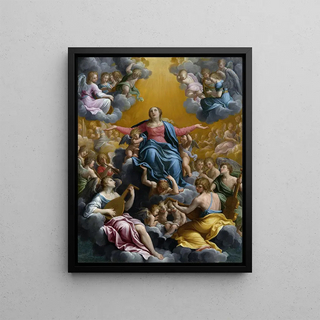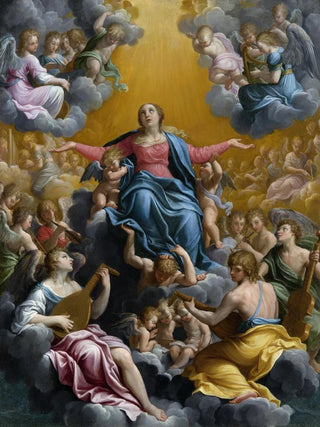Art print | Assumption of the Virgin - Guido Reni


View from behind

Frame (optional)
The Assumption of the Virgin - Guido Reni – Captivating Introduction
The Assumption of the Virgin, an iconic work by the Baroque master Guido Reni, stands as an ode to celestial beauty and spirituality. This painting, created in the 17th century, captures a moment of transcendence where the Virgin Mary, surrounded by angels, ascends toward the sky. The piece, with its brilliance and emotional depth, invites viewers to contemplate the divine elevation of Mary, symbolizing hope and redemption. The light emanating from this sacred scene creates an atmosphere that is both serene and majestic, transporting the observer into a spiritual dimension where the earthly and the celestial converge.
Style and uniqueness of the work
The Assumption of the Virgin is distinguished by the harmony of its colors and the finesse of its details. Reni, a virtuoso of light, employs striking contrasts to highlight the celestial figures. The color palette, rich in golds and blues, evokes divine grandeur while emphasizing the delicacy of the Virgin. The flowing drapery of the robes, rendered with remarkable precision, seems to vibrate under the effect of light, adding dynamism to the composition. The expressions of the angels, blending joy and reverence, reinforce the idea of a sacred moment, while Mary's posture, both humble and majestic, embodies the quintessence of divine femininity. This work, through its bold composition and luminous treatment, remains a striking example of Reni's technical and artistic mastery.
The artist and his influence
Guido Reni, born in Bologna in 1575, is one of the most influential painters of the Baroque movement. Trained in the workshop of the illustrious Carracci, Reni developed a personal style that combines classical idealization with Baroque intensity. His approach to light and color profoundly influenced his contemporaries and left a lasting impact on subsequent generations of artists. The Assumption of the Virgin, among his most famous works, demonstrates his ability to fuse emotion and spirituality, creating a visual experience that transcends

Matte finish

View from behind

Frame (optional)
The Assumption of the Virgin - Guido Reni – Captivating Introduction
The Assumption of the Virgin, an iconic work by the Baroque master Guido Reni, stands as an ode to celestial beauty and spirituality. This painting, created in the 17th century, captures a moment of transcendence where the Virgin Mary, surrounded by angels, ascends toward the sky. The piece, with its brilliance and emotional depth, invites viewers to contemplate the divine elevation of Mary, symbolizing hope and redemption. The light emanating from this sacred scene creates an atmosphere that is both serene and majestic, transporting the observer into a spiritual dimension where the earthly and the celestial converge.
Style and uniqueness of the work
The Assumption of the Virgin is distinguished by the harmony of its colors and the finesse of its details. Reni, a virtuoso of light, employs striking contrasts to highlight the celestial figures. The color palette, rich in golds and blues, evokes divine grandeur while emphasizing the delicacy of the Virgin. The flowing drapery of the robes, rendered with remarkable precision, seems to vibrate under the effect of light, adding dynamism to the composition. The expressions of the angels, blending joy and reverence, reinforce the idea of a sacred moment, while Mary's posture, both humble and majestic, embodies the quintessence of divine femininity. This work, through its bold composition and luminous treatment, remains a striking example of Reni's technical and artistic mastery.
The artist and his influence
Guido Reni, born in Bologna in 1575, is one of the most influential painters of the Baroque movement. Trained in the workshop of the illustrious Carracci, Reni developed a personal style that combines classical idealization with Baroque intensity. His approach to light and color profoundly influenced his contemporaries and left a lasting impact on subsequent generations of artists. The Assumption of the Virgin, among his most famous works, demonstrates his ability to fuse emotion and spirituality, creating a visual experience that transcends






